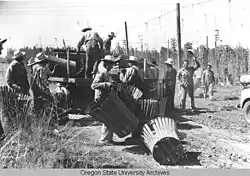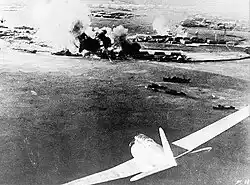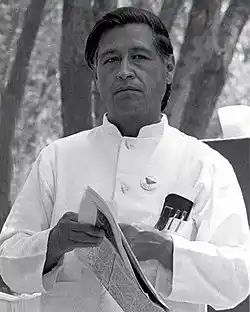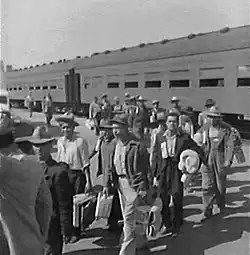
The Bracero Program was a program whereby Mexican workers were allowed to come and work in the United States between 1942 and 1964. Bracero comes from the Spanish term for ‘manual laborer’. The program was established in the context of the United States just having been pulled violently into the Second World War after the Japanese attack on Pearl Harbor in December 1941. With millions of American men being conscripted to go and fight in the Pacific, Asia, Europe and North Africa, and with the US economy now being completely transformed to meet wartime needs, the government in Washington realized it would have a labor shortage and began hiring Mexicans. The number of braceros who were initially employed during the war was actually quite small, less than 200,000 in all. But the Bracero Program was allowed to continue running after the war as American industrial expansion continued. By the time it was brought to an end in 1964, around four and a half million contracts had been issued under it. Many braceros later remained in the US, growing the Mexican American population. More broadly, the Bracero Program helped alter the nature of migration to the US from primarily being from Europe to largely being from Latin America.[1]
Research your ancestors on MyHeritage
Bracero Program chronology of eventsBracero Program chronology of events

Prior to the Second World War, the vast majority of migration into the United States had been in the form of people from Europe arriving to the great ports and cities of the East Coast like New York, Boston and Philadelphia. Millions of people had come from a number of specific countries like Ireland, Italy, Germany and Poland in the nineteenth and early twentieth centuries. There had also been some limited settlement of Japanese and Chinese people on the West Coast and in the Hawaiian Islands. By way of contrast, Latin American migration had been minimal. This was partly because a Spanish-speaker who wanted to migrate for economic reasons in Central or South America in the 1890s, for instance, would be far better off migrating to Buenos Aires in Argentina or Sao Paulo in Brazil, as the economies of these South American countries were booming during the period between around 1870 and 1929.[2]
This all began to change in the twentieth century as political instability and economic decline led to a Latin American exodus into the US. This was fuelled early on by the Bracero Program. Under the terms of the Immigration Act of 1924, the US government had curtailed free migration into the country.[3] Thus, when Washington decided shortly after the attack on Pearl Harbor by the Japanese in December 1941 that more foreign workers would be needed to plug the wartime labor deficit, a new system of ‘guest workers’ or foreign contract workers was needed to get around the terms of the legislation passed in 1924. Mexico was an ideal country to seek out such workers. The border adjoined the US and, while it joined the war on the Allied side in May 1942, it was not a very active participant in it, so Mexico would have men and women who were available to come and work in the US.[4]

The Bracero Program was launched in California in August 1942. Workers from Mexico would be offered contracts and paid 30 cents an hour as a minimum wage. Many arrived to work as agricultural workers on the farms of California or the ranches of Texas and New Mexico. It was not all smooth sailing. Violent encounters in Texas led to the Mexican government prohibiting bracero contracts from that state for several years.[5]
Once the war ended, the Bracero Program was extended. Ultimately it would run until 1964. This mirrors the situation amongst other major wartime participants. Germany was still hiring hundreds of thousands of Turkish ‘guest workers’ as late as the 1960s and the British and Dutch brought in extensive numbers of workers from their colonies between 1945 and the 1960s. The legal status of braceros after their contract expired was a matter of ongoing legal contention. Many tried to remain in the US and there was a protracted debate on whether they should be forced to return home, though many ultimately stayed, started families and acquired citizenship status in the long run.[6] There were also issues around legally arrived migrants being passed over for work in the early 1960s in favor of cheaper bracero workers, something which partly fuelled the protests led by Cesar Chavez in California, Arizona and other regions in the 1960s.[7]
Extent of migration caused by the Bracero ProgramExtent of migration caused by the Bracero Program

The Bracero Program only led to modest migration during the war and the years immediately after it, even as millions of Americans remained overseas policing the liberated territories in Germany, Japan and the like down to 1947 and 1948. Just over a quarter of a million Mexicans had taken up bracero contracts by 1947, five years after it was initiated. However, the US government, which faced labor shortages after the war, just like European countries like Britain, France, the Netherlands and Germany, continued to rely on foreign guest workers to fill the deficit. The Bracero Program continued until 1964. By the time it was brought to an end, approximately four and a half million bracero contracts had been issued. The most active years of all were in the second half of the 1950s, when an average of around 425,000 bracero contracts were issued each year. The majority of this migration was from Mexico to places closer to the US. Huge numbers entered California and Texas, whereas places like North Dakota and Montana would have obviously experienced very little migration. Many of the Mexicans involved remained in the US after their initial contracts ended and started families there.[8]
Demographic impact of the Bracero ProgramDemographic impact of the Bracero Program
Latin Americans constituted less than 2% of the population of the United States when the Bracero Program was initiated in 1942. That number began to shift radically because of the change in attitudes and migratory patterns in the post-war era brought about, in part, by the Bracero Program. By 1964 the figure had increased to nearly 4%. Then it expanded massively over the 1970s and 1980s and has continued to ever since. As of 2025, Latin Americans make up nearly one-fifth of the US population. Certainly, there were many other issues in play in this mass migration, notably the political destabilization of so many Latin American countries in Central America, South America and the Caribbean during the Cold War-era, but the Bracero Program did contribute considerably to a change in mindset, one which informed Mexicans and others that the US was a country where their labor was needed in the same way European migrants had been needed in decades gone by.[9]
See alsoSee also
Explore more about the Bracero ProgramExplore more about the Bracero Program
- Mexico, Baptisms, 1560-1950 records collection on MyHeritage
- Mexico, Marriages, 1570-1950 records collection on MyHeritage
- Mexico, Deaths, 1680-1940 records collection on MyHeritage
- 1950 United States Federal Census records collection on MyHeritage
- United States, Alien Immigration Case Files records collection on MyHeritage
- United States, Alien Case Files records collection on MyHeritage
References
- ↑ Richard B. Craig, The Bracero Program: Interest Groups and Foreign Policy (Austin, Texas, 1971).
- ↑ https://www.pewresearch.org/short-reads/2024/07/22/how-the-origins-of-americas-immigrants-have-changed-since-1850/
- ↑ https://history.state.gov/milestones/1921-1936/immigration-act
- ↑ Alberto Garcia, Abandoning Their Beloved Land: The Politics of Bracero Migration in Mexico (Berkeley, California, 2023).
- ↑ Otey M. Scruggs, ‘Texas and the Bracero Program, 1942–1947’, in Pacific Historical Review, Vol. 32, No. 3 (August, 1963), pp. 251–264.
- ↑ https://www.wilsoncenter.org/article/mexican-braceros-and-us-farm-workers
- ↑ https://prologue.blogs.archives.gov/2023/09/27/the-bracero-program-prelude-to-cesar-chavez-and-the-farm-worker-movement/
- ↑ https://www.thoughtco.com/the-bracero-program-4175798
- ↑ David M. Reimers, ‘Post-World War II Immigration to the United States: America’s Latest Newcomers’, in The Annals of the American Academy of Political and Social Science, Vol. 454, America as a Multicultural Society (March, 1981), pp. 1–12.

